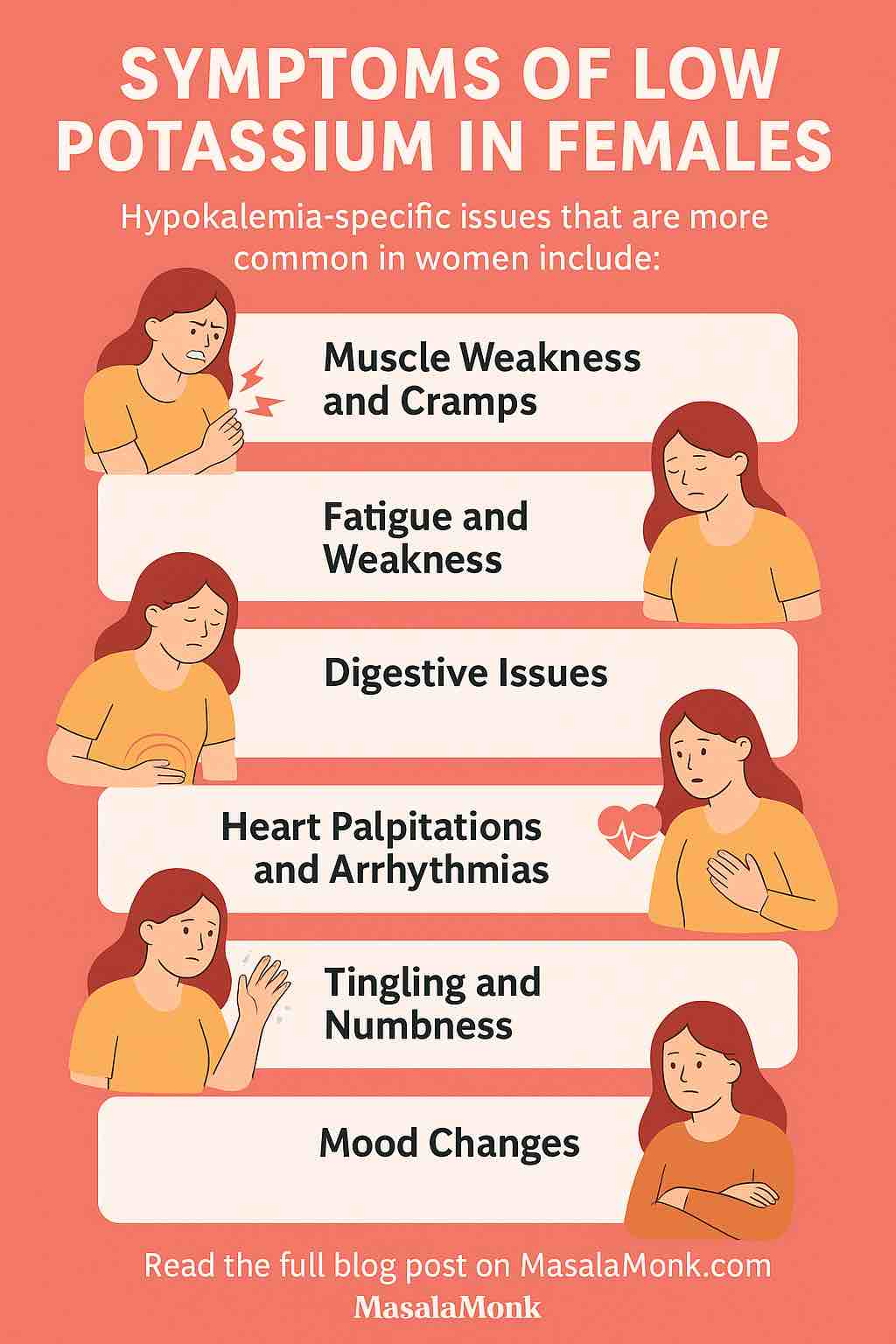
Potassium—an essential mineral often overshadowed by more talked-about nutrients like calcium and iron—plays a critical role in maintaining the body’s electrical and muscular functions. Yet, many women remain unaware of what happens when potassium levels dip too low. Known medically as hypokalemia, low potassium can cause a host of symptoms that are often misattributed to stress, hormonal shifts, or poor sleep. In this article, we’ll explore the unique symptoms of low potassium in females, why they occur, and what you can do about them.
🔍 Why Potassium Matters—Especially for Women
Potassium is vital for nerve conduction, muscle contractions, and heart rhythm regulation. In women, potassium balance becomes especially important due to:
- Hormonal fluctuations (menstrual cycle, pregnancy, menopause)
- Dietary restrictions or preferences
- Use of diuretics or laxatives for weight management or PMS relief
- Chronic conditions such as eating disorders or kidney issues
All these factors can put women at a higher risk for developing hypokalemia—even at mild levels that still cause disruptive symptoms.
⚠️ Common Symptoms of Low Potassium in Females
Let’s break down the signs your body might be giving you:
1. Muscle Weakness, Cramping & Spasms
One of the earliest and most noticeable signs, muscle-related issues are a red flag. Low potassium disrupts the electrical signals between your brain and muscles, leading to:
- Muscle cramps (especially in legs and feet)
- Generalized weakness
- Difficulty climbing stairs or lifting objects
- In severe cases, muscle paralysis
Tip: If you’re experiencing these after workouts or during your menstrual cycle, potassium might be a factor.
2. Fatigue and Lethargy
Feeling run-down even after a full night’s sleep? Potassium helps your cells produce energy efficiently. When it’s low, your cells don’t function at full capacity, leading to:
- Persistent tiredness
- Brain fog
- Lack of motivation
This can mimic symptoms of depression or burnout, making it harder to diagnose.
3. Heart Palpitations or Irregular Beats
Potassium is crucial for cardiac muscle health. Low levels can disrupt heart rhythm and increase the risk of:
- Palpitations
- Arrhythmias (irregular heartbeats)
- Dizziness or fainting spells
Women with a history of heart conditions or who are taking blood pressure medication should be particularly cautious.
4. Digestive Discomfort
Potassium supports the smooth muscles of your digestive tract. A deficiency may slow down digestion, causing:
- Constipation
- Bloating
- Abdominal cramping
Women are already prone to IBS-like symptoms, and low potassium can exacerbate this.
5. Mood Changes & Mental Fog
Emerging research links electrolyte imbalances like low potassium with mood instability. Some women report:
- Anxiety or depressive episodes
- Irritability
- Short-term memory lapses
These symptoms may spike during PMS or menopause, periods when hormones already impact emotional balance.
6. Tingling, Numbness, or Sensory Changes
Potassium supports proper nerve function. In its absence, you might feel:
- Pins-and-needles sensations
- Numbness in extremities
- Unexplained chills or hot flashes
👩⚕️ When to See a Doctor
While many of these symptoms may appear minor or intermittent, persistent signs warrant a medical consultation. Your doctor may recommend a simple blood test to check potassium levels. In some cases, an ECG might be ordered if cardiac symptoms are involved.
Normal potassium range: 3.6 to 5.2 mmol/L. Levels below 3.5 are considered hypokalemic.
🥑 Potassium-Rich Foods to Reclaim Balance
Boosting your potassium intake through diet is often the first line of defense. Top foods include:
- Bananas
- Avocados
- Sweet potatoes
- Spinach
- Lentils
- Coconut water
- Yogurt (especially low-fat options)
Bonus: These foods also provide magnesium, calcium, and fiber—nutrients that work in synergy with potassium.
💊 Medications and Lifestyle Triggers
Certain medications can cause potassium loss, such as:
- Diuretics (often used for high blood pressure or PMS)
- Laxatives (chronic use)
- Steroids
- Some birth control pills
Tip: Always discuss medication side effects with your doctor, especially if you’re experiencing muscle issues or heart irregularities.
✅ Take Charge of Your Electrolyte Health
Potassium is a quiet but powerful regulator in the body, and its deficiency should not be overlooked. Women, due to physiological and lifestyle variables, are particularly vulnerable. Listening to your body’s warning signs—and knowing they could be tied to a simple mineral imbalance—can be the first step toward reclaiming your energy, focus, and vitality.
If you’ve been battling symptoms without clear answers, ask your doctor about potassium—and consider getting your levels tested.
📌 Quick Recap:
| Symptom | Why It Happens | What You Can Do |
|---|---|---|
| Muscle cramps/weakness | Electrical signal disruption in muscles | Eat potassium-rich foods, hydrate |
| Fatigue | Impaired cellular energy production | Monitor diet, test potassium levels |
| Palpitations | Irregular heart electrical activity | ECG, electrolyte panel |
| Constipation | Sluggish bowel muscle contractions | Fiber + potassium intake |
| Mood swings | Nervous system affected by electrolyte shifts | Balanced diet, consult physician |
| Tingling/numbness | Nerve misfiring | Check potassium and magnesium |
💬 Share Your Experience
Have you dealt with symptoms of low potassium? What changes helped you recover? Share your story in the comments to help others become more aware.
🔹 FAQs on Low Potassium in Females
1. What causes low potassium levels in women?
Low potassium (hypokalemia) can be caused by poor diet, excessive sweating, vomiting, diarrhea, use of diuretics or laxatives, kidney issues, hormonal changes (like during menstruation or menopause), and certain medications such as corticosteroids and birth control pills.
2. How do I know if my symptoms are due to low potassium?
If you’re experiencing persistent fatigue, muscle cramps, heart palpitations, or digestive issues, and there’s no clear cause, a simple blood test can determine your potassium levels. Consulting a healthcare provider is the best course of action.
3. Are women more at risk for low potassium than men?
Yes. Hormonal fluctuations, dieting patterns, higher use of diuretics, and menstrual-related fluid loss can put women at a higher risk compared to men.
4. Can low potassium affect my menstrual cycle?
While low potassium doesn’t directly alter your menstrual cycle, it can worsen PMS symptoms like fatigue, mood swings, and cramps, and may contribute to irregularities if tied to broader nutritional deficiencies.
5. Can low potassium cause anxiety or depression?
Yes. Low potassium can impact the nervous system and brain function, potentially leading to symptoms like mood swings, anxiety, confusion, and even depression in some cases.
6. What foods are best for increasing potassium naturally?
Foods rich in potassium include bananas, avocados, sweet potatoes, spinach, lentils, oranges, coconut water, yogurt, and white beans. A balanced diet incorporating these can help maintain healthy potassium levels.
7. Can I take potassium supplements without a prescription?
Over-the-counter potassium supplements exist, but high doses can be dangerous. It’s crucial to confirm a deficiency with your doctor before starting any supplements.
8. What’s the ideal potassium level in blood?
Normal blood potassium levels range from 3.6 to 5.2 mmol/L. Levels below 3.5 mmol/L indicate hypokalemia and require medical attention.
9. Can low potassium be life-threatening?
Yes, if left untreated, severe hypokalemia can cause serious complications like cardiac arrhythmias, paralysis, and even respiratory failure.
10. How quickly can potassium levels be restored?
Mild deficiencies can often be corrected within a few days with dietary changes. More severe cases may require oral or IV potassium under medical supervision.














